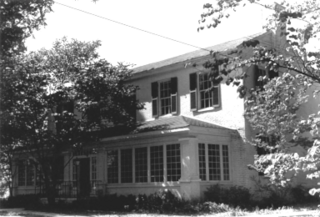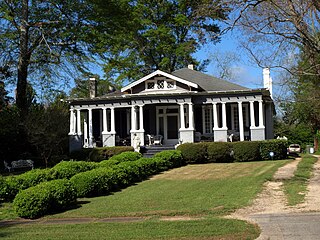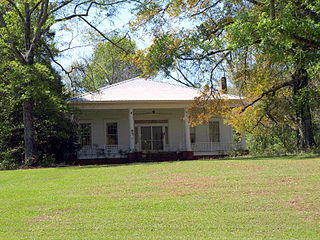Minard Lafever (1798–1854) was an American architect of churches and houses in the United States in the early nineteenth century.

Ashe Cottage, also known as the Ely House, is a historic Carpenter Gothic house in Demopolis, Alabama. It was built in 1832 and expanded and remodeled in the Gothic Revival style in 1858 by William Cincinnatus Ashe, a physician from North Carolina. The cottage is a 1+1⁄2-story wood-frame building, the front elevation features two semi-octagonal gabled front bays with a one-story porch inset between them. The gables and porch are trimmed with bargeboards in a design taken from Samuel Sloan's plan for "An Old English Cottage" in his 1852 publication, The Model Architect. The house is one of only about twenty remaining residential examples of Gothic Revival architecture remaining in the state. Other historic Gothic Revival residences in the area include Waldwic in Gallion and Fairhope Plantation in Uniontown. Ashe Cottage was added to the Alabama Register of Landmarks and Heritage on August 22, 1975, and to the National Register of Historic Places on 19 October 1978.

The First White House of the Confederacy is a historic house in Montgomery, Alabama, which was the initial executive residence of President of the Confederate States of America Jefferson Davis and family during early 1861. Moved from its original location in 1919 and completely furnished with original period pieces from the 1850s and 1860s, the 1835 Italianate-style house is open to the public. It has been listed on the National Register of Historic Places since 1974 and the Alabama Register of Landmarks and Heritage since 2012.

The William King Beck House, also known as River Bluff Plantation, is a historic plantation house on the Alabama River near Camden, Alabama. The main house was built in 1845 for William King Beck and is attributed to architect Alexander J. Bragg. William King Beck was an attorney from North Carolina who migrated to Wilcox County in the 1820s. He was the nephew of William Rufus King, the 13th Vice President of the United States.

The Ackerville Baptist Church of Christ is a historic Baptist Church of Christ building in Ackerville, Alabama. The one-story Greek Revival style church was built in 1848. It was added to the Alabama Register of Landmarks and Heritage on July 22, 1991 and to the National Register of Historic Places on April 18, 2003 due to its architectural significance.

The Edwin Reese House, also known as the Reese-Phillips House, is a historic Greek Revival style house in Eutaw, Alabama, United States. The house is a two-story wood-frame building on a raised brick foundation. Four monumental Ionic columns span the front portico. It was built from 1856 to 1859 by Edwin Reese. The house was recorded by the Historic American Buildings Survey in 1936. It was listed on the Alabama Register of Landmarks and Heritage on October 17, 1980. It was added to the National Register of Historic Places as a part of the Antebellum Homes in Eutaw Thematic Resource on April 2, 1982, due to its architectural significance.

The Catlin Wilson House, also known as the Murphy Dunlap House, is a historic Greek Revival style house in Eutaw, Alabama, United States. The one-story wood-framed building was built in 1844. A pedimented front portico with four Doric columns covers the three central bays of the front facade. The house was recorded by the Historic American Buildings Survey in 1936. It was listed on the Alabama Register of Landmarks and Heritage on November 5, 1976. It was subsequently added to the National Register of Historic Places as a part of the Antebellum Homes in Eutaw Thematic Resource on April 2, 1982, due to its architectural significance.

The Gustave Braune House is a historic house at 236 Prairie Street in Eutaw, Alabama.

The Stone Plantation, also known as the Young Plantation and the Barton Warren Stone House, is a historic Greek Revival-style plantation house and one surviving outbuilding along the Old Selma Road on the outskirts of Montgomery, Alabama. It had been the site of a plantation complex, and prior to the American Civil War it was known for cotton production worked by enslaved people.
The Brame House, also known as the Brame-Cody-Neal House, was a historic Classical Revival-style house in Montgomery, Alabama. The two-story frame house was built in 1897 by W.W. Brame. It was added to the Alabama Register of Landmarks and Heritage on January 29, 1980, and to the National Register of Historic Places on September 17, 1980. The house was demolished in 1990, after some attempts were made to save it.

The Wilson–Finlay House also known as the Joshua Wilson House and the Finlay House, is a historic plantation house in Gainestown, Alabama. It was added to the Alabama Register of Landmarks and Heritage on September 17, 1976. It was placed on the National Register of Historic Places on July 12, 1978, due to its architectural significance.

The Dr. John R. Drish House, also known simply as the Drish House, is a historic plantation house in Tuscaloosa, Alabama, United States. It is considered by state preservationists to be one of the most distinctive mixes of the Greek Revival and Italianate styles in Alabama. First recorded by the Historic American Buildings Survey in 1934, it was added to the Alabama Register of Landmarks and Heritage on July 31, 1975, and subsequently to the state's "Places in Peril" listing in 2006. It was listed as Jemison School-Drish House on the National Register of Historic Places in 2015.

The James Spullock Williamson House, also known as Merry Oaks, is a historic plantation house in the rural community of Sandy Ridge in Lowndes County, Alabama. The one-story Greek Revival-style house was completed circa 1860.

The Littleberry Pippen House is a historic house in Eutaw, Alabama. The one-story wood-frame house was built in the early 1840s. It features Greek Revival-style architecture, with inspiration drawn from Creole cottage forms. It was added to the National Register of Historic Places as part of the Antebellum Homes in Eutaw Thematic Resource on April 2, 1982.

Flint River Place is a historic residence near Huntsville, Alabama. The house was built between 1844 and 1850 by Daniel Friend, a planter who came to Alabama from Kentucky around 1826. The house is Greek Revival in style, with Federal and Georgian Revival elements. It began as an L-shaped house, with an additional ell and one-story shed roofed infill built in 1930. The house is clad in poplar siding and the gable roof was originally slate over wooden shingles, but has been replaced by asphalt shingles. Two gable-end chimneys have simple, Federal-style mantels. The façade is three bays, with a one-story portico supported by four columns, with a balcony above; it replaced a gable-roofed, two-column portico in 1978. The main entrance is flanked by sidelights and topped with a fanlight. Windows on the entire house, except for the southeast bedroom addition, are six-over-nine sashes. The house was listed on the Alabama Register of Landmarks and Heritage in 1981 and National Register of Historic Places in 1982. The house was heavily damaged in a fire in 2012.

The Leech–Hauer House was a historic residence in Huntsville, Alabama. It was built circa 1830 by professional carpenter William Leech. It was built in a transitional style between Federal and Greek Revival. The house was a two-story, L-shaped structure, with a front porch which was later enclosed. John G. Hauer purchased the house in 1904, and it remained a family residence until it was sold to a flower shop in 1974. It was purchased by physician Parker Griffith and his brother in 1977. The house was listed on the Alabama Register of Landmarks and Heritage and National Register of Historic Places in 1978. The house was subsequently demolished, and a modern medical office building was constructed on the site in 1988.

Winston Place is a historic residence in Valley Head, Alabama. William O. Winston, a lawyer from Rogersville, Tennessee, moved to DeKalb County in 1838. Winston would later serve in the Alabama House of Representatives and was a major investor in the Wills Valley Railroad, which would later connect Chattanooga with Birmingham. Soon after arriving in Alabama, Winston built a two-story I-house. In the late 19th century, the exterior was extensively modified with a two-story, wrap-around, Colonial Revival porch and tetrastyle portico. Around 1930, rear outbuildings were connected to the house, giving it an L-shaped plan. The house was listed on the Alabama Register of Landmarks and Heritage in 1976 and the National Register of Historic Places in 1987.

The James Martin House is a historic residence in Florence, Alabama. Martin was a leading Florence industrialist of the Antebellum era, who owned a cotton spinning mill along Cypress Creek. He had come to Florence from Jefferson County, Kentucky, and established his mill in 1839. A fire destroyed the complex in 1844, but was rebuilt and reopened in 1850. The mill was destroyed during the Civil War, but not rebuilt before Martin's death in 1869. Martin's sons operated the mill until 1873, and owned the house until 1879. It was purchased in 1886 by John Bounds, and remained in his family until 1974.

The Fort Dale-College Street Historic District is a historic district in Greenville, Alabama. The district contains Greenville's oldest existing affluent residences, dating to as early as the 1850s. In the initial federal land sale following the Creek War, the area that became northwest Greenville was claimed by William Dunklin. Dunklin sold the claim to William Burnette, who began to parcel the land for sale and to give to family members. Burnette's daughter and son-in-law built a Corinthian-columned Greek Revival home in 1857. A few other pre-Civil War houses remain, and construction continued after the war, including a school building that was later converted into a house. Most of the early residences were large, and built in Greek Revival, Second Empire, and Colonial Revival styles. Beginning in the 20th century, bungalows and cottages on smaller lots began to emerge. One of the later constructions in the district is a Spanish Colonial Revival house, built in 1928.

The John W. Howard House is a historic residence near Greenville, Alabama. It was built around 1860 by planter John W. Howard. While much of the land was sold off and used for timber, Howard's family continued to occupy the house at least through 1992. The house is a one-story, Greek Revival structure with an inset front porch. The façade is five bays wide, and the central entrance has double doors with multi-light sidelights and transom. The interior is a triple-pile center-hall plan. Outbuildings include a frame barn, a two-room detached kitchen, and the family cemetery.




















